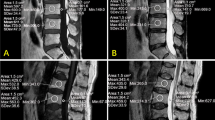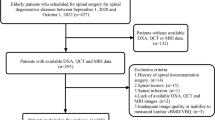Abstract
Objective
To explore the characteristics of vertebral bone quality (VBQ) scores in patients with vertebral fragility fractures, including VBQ score and single-level VBQ score, and evaluate their effectiveness as predictors.
Methods
The VBQ scores were measured using T1-weighted MRI images. VBQ scores were compared in patients with different times of previous fragility fractures. In addition, patients with fractures were matched for age and sex with patients without fractures, and VBQ scores were compared between the two groups. Finally, the predictive efficiency of VBQ scores for vertebral fragility fractures was analyzed by the receiver-operator curve (ROC).
Results
The average VBQ score and single-level VBQ score in patients with fractures were 3.48 ± 0.56 and 3.60 ± 0.60 and no difference among patients with different times of previous fractures. As for the age- and sex-matched patients, fracture patients had higher VBQ scores (VBQ score: 3.48 ± 0.56 vs. 2.88 ± 0.40, p < 0.001; single-level VBQ score: 3.60 ± 0.60 vs. 2.95 ± 0.44, p < 0.001). The AUCs using the VBQ score and single-level VBQ score to predict fragility fractures were 0.815 and 0.817, respectively. The optimal thresholds of the VBQ score and single-level VBQ score for predicting fragility fractures were 3.22 and 3.16, respectively.
Conclusion
MRI‑based VBQ scores are important predictors of vertebral fragility fracture but have no predictive value for the recurrence of fractures in patients with a history of fragility fractures. The VBQ score of 3.22 and single-level VBQ score of 3.16 are optimal thresholds that can be used when using lumbar MRI scans to identify individuals at high risk for fragility fractures.



Similar content being viewed by others
Data availability
Data are not publicly available due to containing patient privacy. Data may be obtained from the corresponding author on reasonable request.
References
Cheng X, Zhao K, Zha X et al (2021) Opportunistic screening using low-dose CT and the prevalence of osteoporosis in China: a nationwide multicenter study. J Bone Miner Res 36(3):427–435. https://doi.org/10.1002/jbmr.4187
Compston JE, Mcclung MR, Leslie WD (2019) Osteoporosis. Lancet 393(10169):364–376. https://doi.org/10.1016/s0140-6736(18)32112-3
Yu F, Xia W (2019) The epidemiology of osteoporosis, associated fragility fractures, and management gap in China. Arch Osteoporos 14(1):32. https://doi.org/10.1007/s11657-018-0549-y
Muraki S, Yamamoto S, Ishibashi H et al (2004) Impact of degenerative spinal diseases on bone mineral density of the lumbar spine in elderly women. Osteoporos Int 15(9):724–728. https://doi.org/10.1007/s00198-004-1600-y
Schuit SC, Van Der Klift M, Weel AE et al (2004) Fracture incidence and association with bone mineral density in elderly men and women: the Rotterdam study. Bone 34(1):195–202. https://doi.org/10.1016/j.bone.2003.10.001
Lee SJ, Binkley N, Lubner MG et al (2016) Opportunistic screening for osteoporosis using the sagittal reconstruction from routine abdominal CT for combined assessment of vertebral fractures and density. Osteoporos Int 27(3):1131–1136. https://doi.org/10.1007/s00198-015-3318-4
Anderson PA, Polly DW, Binkley NC et al (2018) Clinical use of opportunistic computed tomography screening for osteoporosis. J Bone Joint Surg Am 100(23):2073–2081. https://doi.org/10.2106/jbjs.17.01376
Zou D, Li W, Deng C et al (2019) The use of CT Hounsfield unit values to identify the undiagnosed spinal osteoporosis in patients with lumbar degenerative diseases. Eur Spine J 28(8):1758–1766. https://doi.org/10.1007/s00586-018-5776-9
Schreiber JJ, Anderson PA, Rosas HG et al (2011) Hounsfield units for assessing bone mineral density and strength: a tool for osteoporosis management. J Bone Joint Surg Am 93(11):1057–1063. https://doi.org/10.2106/jbjs.J.00160
Lee SJ, Graffy PM, Zea RD et al (2018) Future osteoporotic fracture risk related to lumbar vertebral trabecular attenuation measured at routine body CT. J Bone Miner Res 33(5):860–867. https://doi.org/10.1002/jbmr.3383
Zou D, Ye K, Tian Y et al (2020) Characteristics of vertebral CT Hounsfield units in elderly patients with acute vertebral fragility fractures. Eur Spine J 29(5):1092–1097. https://doi.org/10.1007/s00586-020-06363-1
Ehresman J, Pennington Z, Schilling A et al (2020) Novel MRI-based score for assessment of bone density in operative spine patients. Spine J 20(4):556–562. https://doi.org/10.1016/j.spinee.2019.10.018
Ehresman J, Schilling A, Yang X et al (2021) Vertebral bone quality score predicts fragility fractures independently of bone mineral density. Spine J 21(1):20–27. https://doi.org/10.1016/j.spinee.2020.05.540
Haffer H, Muellner M, Chiapparelli E et al (2022) Bone quality in patients with osteoporosis undergoing lumbar fusion surgery: analysis of the MRI-based vertebral bone quality score and the bone microstructure derived from microcomputed tomography. Spine J 22(10):1642–1650. https://doi.org/10.1016/j.spinee.2022.05.008
Salzmann SN, Okano I, Jones C et al (2022) Preoperative MRI-based vertebral bone quality (VBQ) score assessment in patients undergoing lumbar spinal fusion. Spine J 22(8):1301–1308. https://doi.org/10.1016/j.spinee.2022.03.006
Kadri A, Binkley N, Hernando D et al (2022) Opportunistic use of lumbar magnetic resonance imaging for osteoporosis screening. Osteoporos Int 33(4):861–869. https://doi.org/10.1007/s00198-021-06129-5
Pickhardt PJ, Pooler BD, Lauder T et al (2013) Opportunistic screening for osteoporosis using abdominal computed tomography scans obtained for other indications. Ann Intern Med 158(8):588–595. https://doi.org/10.7326/0003-4819-158-8-201304160-00003
Kim AYE, Lyons K, Sarmiento M, et al (2022) MRI-based score for assessment of bone mineral density in operative spine patients. Spine (Phila Pa 1976). https://doi.org/10.1097/brs.0000000000004509
Li R, Yin Y, Ji W et al (2022) MRI-based vertebral bone quality score effectively reflects bone quality in patients with osteoporotic vertebral compressive fractures. Eur Spine J 31(5):1131–1137. https://doi.org/10.1007/s00586-022-07177-z
Schilling AT, Ehresman J, Pennington Z et al (2021) Interrater and intrarater reliability of the vertebral bone quality score. World Neurosurg 154:e277–e282. https://doi.org/10.1016/j.wneu.2021.07.020
Ehresman J, Schilling A, Pennington Z et al (2019) A novel MRI-based score assessing trabecular bone quality to predict vertebral compression fractures in patients with spinal metastasis. J Neurosurg Spine 32:499–506. https://doi.org/10.3171/2019.9.Spine19954
Graffy PM, Lee SJ, Ziemlewicz TJ et al (2017) Prevalence of vertebral compression fractures on routine CT scans according to L1 trabecular attenuation: determining relevant thresholds for opportunistic osteoporosis screening. AJR Am J Roentgenol 209(3):491–496. https://doi.org/10.2214/ajr.17.17853
Gawel SH, Davis GJ, Luo M et al (2020) Serum biomarkers that predict lean mass loss over bed rest in older adults: an exploratory study. Clin Chim Acta 509:72–78. https://doi.org/10.1016/j.cca.2020.06.003
Acknowledgements
We are grateful to all study participants for their participation in the study.
Funding
None of the authors received funding from other individuals or institutions.
Author information
Authors and Affiliations
Contributions
WL and HZ equally participated in data collection and article writing. JL participated in data collection. HT participated in statistical analysis. JL participated in the language editing. LW participated in the design of the study and the revision of the manuscript. All authors read and approve the final version of the manuscript.
Corresponding author
Ethics declarations
Conflict of interest
The authors declare no competing interests.
Consent for publication
Not applicable.
Ethical approval
The study was approved by the ethical committee of The Third Affiliated Hospital of Hebei Medical University. In the study, the need for written informed consent was waived by the ethical committee of The Third Affiliated Hospital of Hebei Medical University due to the retrospective nature of the study. All methods were carried out by relevant guidelines and regulations.
Additional information
Publisher's Note
Springer Nature remains neutral with regard to jurisdictional claims in published maps and institutional affiliations.
Rights and permissions
Springer Nature or its licensor (e.g. a society or other partner) holds exclusive rights to this article under a publishing agreement with the author(s) or other rightsholder(s); author self-archiving of the accepted manuscript version of this article is solely governed by the terms of such publishing agreement and applicable law.
About this article
Cite this article
Li, W., Zhu, H., Liu, J. et al. Characteristics of MRI‑based vertebral bone quality scores in elderly patients with vertebral fragility fractures. Eur Spine J 32, 2588–2593 (2023). https://doi.org/10.1007/s00586-023-07744-y
Received:
Revised:
Accepted:
Published:
Issue Date:
DOI: https://doi.org/10.1007/s00586-023-07744-y




